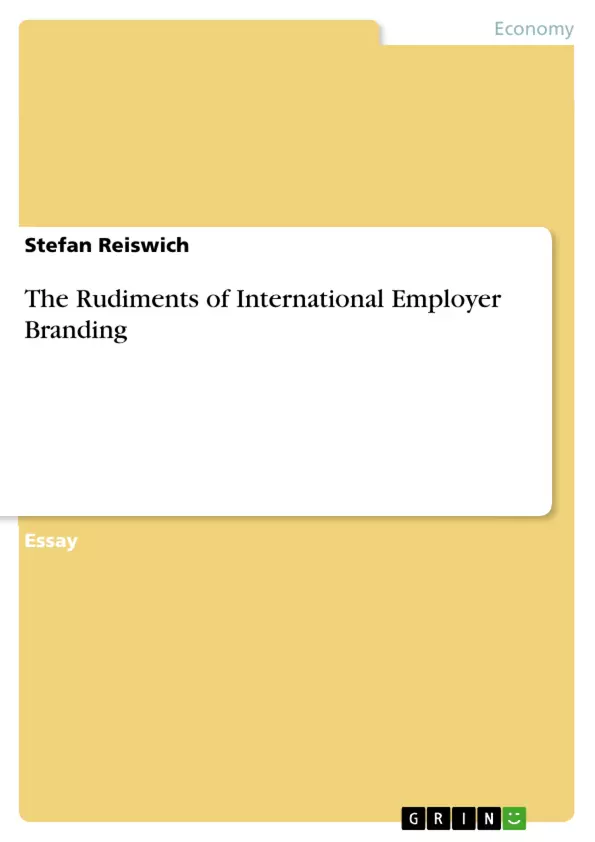In order to understand the International Employer Branding, the first task is to define the meaning of it and to clarify why the Employer Branding is so important for companies.
On the one hand, the Employer Branding is a result of the increasing competitiveness on the labor market, called ‘war of talents’, and the search for experienced and professionalized employees. Especially the social developments are responsible for the difficulties which companies have. The demographic change in Germany leads to a shortage of the population and of the number of young people which are available on the labor market. Companies cannot influence this natural change but they do have an impact on their quality and corporate identity as an employer: This is where the Employer Branding takes place (Immerschitt, Stumpf: 2014, 1). Nowadays, people who are searching for a job are not only interested in an explicit job description, but also in the characteristics and values that a company represents. They ask themselves "What benefits is the employer able to offer?" or "What about the work-life balance?". This is why job descriptions are not only mentioning factors just as remuneration and working hours, but also the working environment and social factors. On the other hand, employers also have to find ways to bind existing employees to the company in the long run in order to protect themselves from a possible drain of know-how and from the costs of finding new employees.
So by definition, the Employer Branding describes all active, strategic actions in order to make a company attractive to both existing and potential new employees. It is used to form a unique selling proposition (USP) to give an answer to the question why potential employees should decide to work in this specific company and not to prefer another one. Companies should create a brand as a good employer and advertise this brand on the labor market, where companies can be seen as products. Real marketing campaigns are also possible to gain the best employees by giving the audience the main arguments why the company differentiates from the others. Therefore, the employer should convey its norms, values and its identity.
Inhaltsverzeichnis (Table of Contents)
- Definition
- Goals
- Employee recruitment (External Employer Branding)
- Employee retention (Internal Employer Branding)
- Corporate culture
- Performance and results
- Measures
- Connection to the class project with Europa‐Service Nordthüringen
- Source directory
Zielsetzung und Themenschwerpunkte (Objectives and Key Themes)
This text aims to provide a comprehensive overview of International Employer Branding. It explores the definition, goals, and measures involved in creating a strong employer brand. The text further analyzes the connection between International Employer Branding and the challenges faced by small and medium enterprises (SMEs) in attracting and retaining skilled employees.
- Definition and Importance of Employer Branding
- Goals of Employer Branding: Recruitment, Retention, Culture, and Performance
- Measures for Building a Strong Employer Brand: Internal and External Strategies
- Challenges and Opportunities for SMEs in International Employer Branding
- The Significance of Employer Branding in a Competitive Labor Market
Zusammenfassung der Kapitel (Chapter Summaries)
- Definition: This chapter defines International Employer Branding and explains its significance in a competitive labor market. It discusses the increasing importance of company culture and values for attracting and retaining employees.
- Goals: This chapter explores the various goals of Employer Branding, including employee recruitment, retention, development of corporate culture, and improvement of performance and results. It also differentiates between Employer Brand and Employer Image.
- Measures: This chapter discusses key measures companies can take to create a strong Employer Branding. It highlights the importance of internal alignment and external communication, and provides examples of successful Employer Branding campaigns.
- Connection to the class project with Europa‐Service Nordthüringen: This chapter connects the concepts discussed in the text with the class project involving Europa‐Service Nordthüringen. It analyzes the specific challenges faced by SMEs in peripheral areas and suggests strategies for building an effective International Employer Brand in such contexts.
Schlüsselwörter (Keywords)
The main keywords and focus topics of this text include Employer Branding, International Employer Branding, employee recruitment, employee retention, corporate culture, performance, measures, SMEs, and challenges in attracting and retaining skilled employees.
- Quote paper
- Stefan Reiswich (Author), 2015, The Rudiments of International Employer Branding, Munich, GRIN Verlag, https://www.grin.com/document/312361



